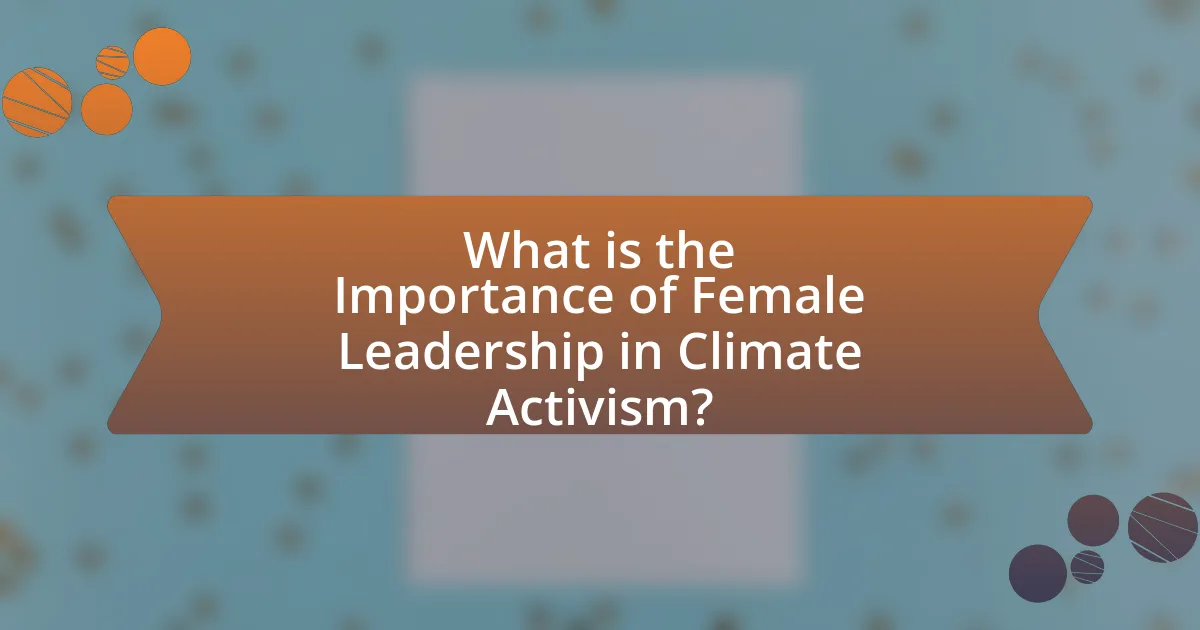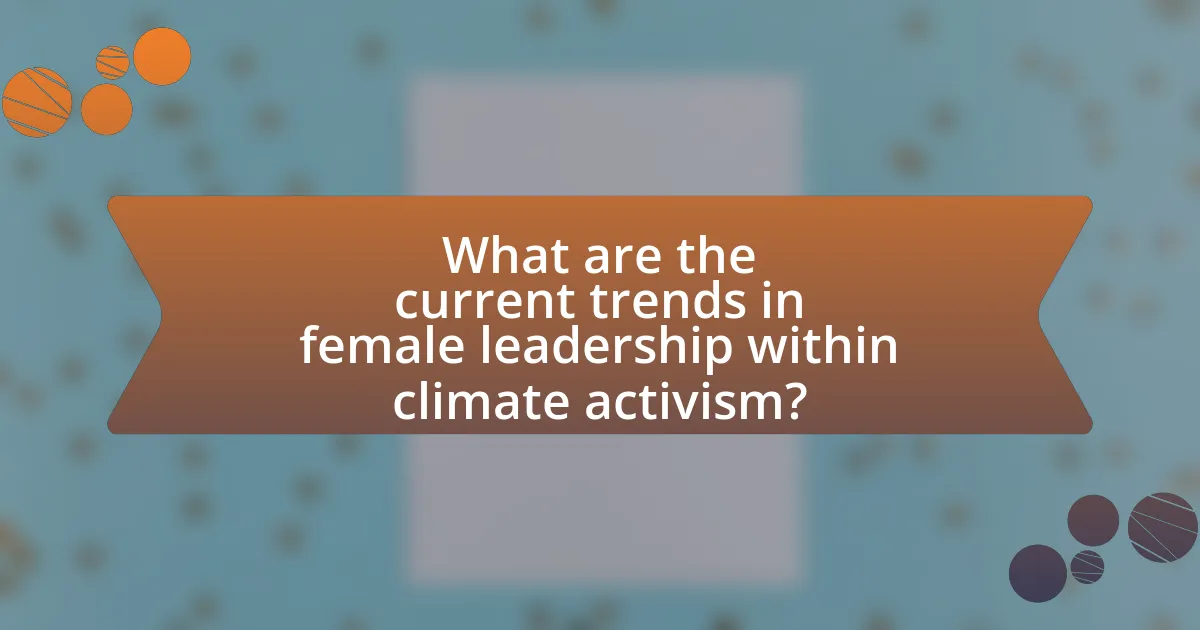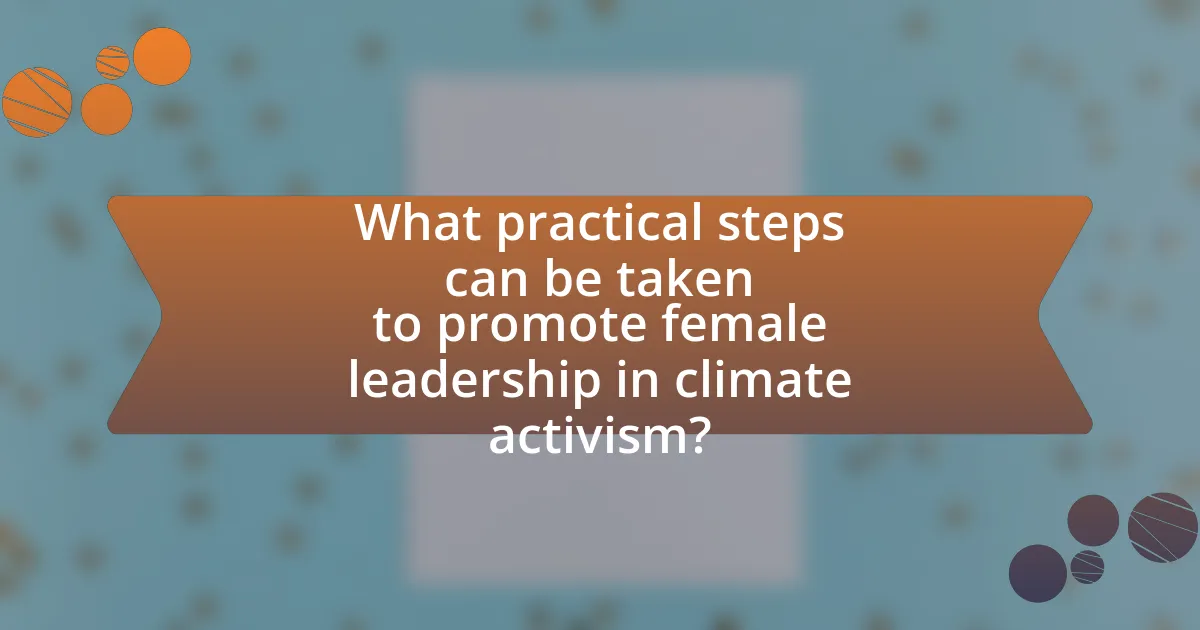The article emphasizes the critical role of female leadership in climate activism, highlighting how women’s diverse perspectives and innovative solutions contribute to more effective climate policies. It discusses the unique viewpoints women bring to environmental issues, their influence on decision-making processes, and the challenges they face, including gender-based discrimination and limited access to resources. The article also explores current trends in female leadership, notable activists, and the importance of education and mentorship in fostering women’s roles in climate initiatives. Additionally, it outlines practical steps organizations can take to promote female leadership and enhance the effectiveness of climate activism.

What is the Importance of Female Leadership in Climate Activism?
Female leadership in climate activism is crucial because it brings diverse perspectives and innovative solutions to environmental challenges. Research indicates that women often prioritize sustainability and community well-being, leading to more effective climate policies. For instance, a study by the Global Gender and Climate Alliance found that women’s participation in decision-making processes can enhance the effectiveness of climate action initiatives. Furthermore, female leaders often advocate for inclusive approaches that consider the needs of marginalized communities, thereby fostering broader support for climate initiatives. This combination of diverse viewpoints and a focus on equity strengthens the overall impact of climate activism.
Why is female leadership crucial in the fight against climate change?
Female leadership is crucial in the fight against climate change because women often bring unique perspectives and solutions that address the multifaceted nature of environmental issues. Research indicates that countries with higher female representation in leadership roles tend to adopt more effective climate policies and prioritize sustainable development. For example, a study published in the journal “Nature Climate Change” found that women leaders are more likely to support climate action initiatives and engage in collaborative decision-making processes, which are essential for addressing complex challenges like climate change. This correlation highlights the importance of female leadership in fostering innovative approaches and inclusive strategies that can lead to more effective climate solutions.
What unique perspectives do women bring to climate activism?
Women bring diverse perspectives to climate activism, emphasizing community resilience, social justice, and intergenerational equity. Their experiences often highlight the disproportionate impact of climate change on marginalized communities, leading to a focus on inclusive solutions that address both environmental and social issues. Research shows that women are more likely to advocate for sustainable practices and policies that benefit entire communities, as evidenced by initiatives led by women in various regions, such as the Green Belt Movement in Kenya, founded by Wangari Maathai, which integrates environmental conservation with women’s rights. This unique viewpoint fosters collaborative approaches that enhance the effectiveness of climate action.
How does female leadership influence climate policy and decision-making?
Female leadership significantly influences climate policy and decision-making by promoting inclusive and collaborative approaches that prioritize sustainability. Research indicates that women leaders are more likely to advocate for environmental protection and climate action, as evidenced by a study published in the journal “Nature Climate Change,” which found that countries led by women tend to implement more stringent climate policies. Additionally, female leaders often emphasize social equity in climate initiatives, addressing the needs of vulnerable populations, which enhances the effectiveness of climate strategies. This focus on inclusivity and sustainability leads to more comprehensive and impactful climate policies.
What challenges do women face in climate activism?
Women face significant challenges in climate activism, including gender-based discrimination, lack of representation, and limited access to resources. Gender-based discrimination often manifests in the form of societal biases that undermine women’s voices and contributions in environmental discussions. For instance, a report by the United Nations Environment Programme highlights that women are underrepresented in decision-making roles related to climate policies, which limits their influence on critical issues. Additionally, women frequently encounter barriers to funding and resources, as studies show that female-led initiatives receive less financial support compared to their male counterparts. These challenges hinder women’s ability to lead effectively in climate activism and diminish the overall impact of their efforts.
How do societal norms impact women’s roles in climate movements?
Societal norms significantly influence women’s roles in climate movements by often limiting their participation and leadership opportunities. Traditional gender roles frequently assign women responsibilities related to caregiving and domestic duties, which can restrict their ability to engage in activism. For instance, a study by the United Nations Development Programme found that women are underrepresented in decision-making roles within environmental organizations, with only 30% of leadership positions held by women globally. This disparity is exacerbated by societal expectations that prioritize male voices in public discourse, thereby marginalizing women’s contributions to climate action. Additionally, cultural perceptions of women’s capabilities can hinder their access to resources and networks essential for effective activism, further entrenching gender inequalities in climate movements.
What barriers exist for women leaders in environmental organizations?
Barriers for women leaders in environmental organizations include gender bias, lack of access to networks, and insufficient representation in decision-making roles. Gender bias manifests in stereotypes that question women’s competence and authority, often leading to fewer leadership opportunities. Additionally, women frequently face challenges in accessing professional networks that are crucial for career advancement, limiting their ability to gain support and mentorship. Furthermore, women are underrepresented in key decision-making positions within these organizations, which can hinder their influence on policies and initiatives. According to a report by the United Nations Environment Programme, women hold only 30% of leadership roles in environmental organizations, highlighting the systemic barriers they encounter.
How can female leadership enhance climate activism effectiveness?
Female leadership can enhance climate activism effectiveness by fostering inclusive decision-making and diverse perspectives. Research indicates that organizations led by women often prioritize sustainability and social responsibility, leading to more comprehensive climate strategies. For instance, a study published in the journal “Nature Climate Change” found that female leaders are more likely to advocate for climate policies that address social equity, which can mobilize broader community support. Additionally, women in leadership roles tend to excel in collaborative approaches, which are crucial for building coalitions and engaging various stakeholders in climate initiatives. This collaborative style not only strengthens community ties but also amplifies the impact of climate activism efforts.
What strategies can women leaders employ to mobilize communities?
Women leaders can mobilize communities by fostering inclusive dialogue, leveraging social media for outreach, and building partnerships with local organizations. Inclusive dialogue allows women leaders to engage diverse community members, ensuring that various perspectives are heard and valued, which enhances community cohesion. Utilizing social media platforms enables leaders to disseminate information quickly and effectively, reaching a broader audience and encouraging participation in climate activism initiatives. Additionally, forming partnerships with local organizations can amplify resources and expertise, creating a more robust support network for community mobilization efforts. Research shows that women-led initiatives in climate activism often result in higher community engagement and participation rates, demonstrating the effectiveness of these strategies.
How does collaboration among female leaders strengthen climate initiatives?
Collaboration among female leaders strengthens climate initiatives by fostering diverse perspectives and innovative solutions. Female leaders often prioritize inclusivity and community engagement, which enhances the effectiveness of climate strategies. For instance, research from the Global Gender and Climate Alliance indicates that women’s participation in decision-making processes leads to more comprehensive and sustainable environmental policies. Additionally, studies show that countries with higher female representation in leadership roles are more likely to adopt ambitious climate targets, demonstrating the tangible impact of female collaboration on climate action.

What are the current trends in female leadership within climate activism?
Current trends in female leadership within climate activism include increased visibility and influence of women in decision-making roles, a focus on intersectionality, and the rise of grassroots movements led by women. Women are increasingly occupying leadership positions in major climate organizations, such as the United Nations Framework Convention on Climate Change, where women leaders advocate for equitable climate policies. Additionally, the emphasis on intersectionality highlights how climate change disproportionately affects marginalized communities, prompting female leaders to address these disparities. Grassroots movements, exemplified by figures like Greta Thunberg and organizations like Fridays for Future, showcase the power of young women mobilizing for climate action, reflecting a shift towards inclusive and diverse leadership in the climate movement.
How are women shaping the future of climate movements?
Women are significantly shaping the future of climate movements through leadership roles, grassroots activism, and innovative solutions. Female leaders, such as Greta Thunberg and Wangari Maathai, have mobilized global awareness and action on climate issues, demonstrating the effectiveness of women’s voices in advocacy. Research from the United Nations indicates that women are often more affected by climate change and thus bring unique perspectives and solutions to the table, emphasizing sustainability and community resilience. Furthermore, studies show that organizations led by women are more likely to prioritize environmental sustainability, highlighting the critical role of female leadership in driving impactful climate action.
What notable female leaders are making an impact in climate activism today?
Notable female leaders making an impact in climate activism today include Greta Thunberg, Vanessa Nakate, and Christiana Figueres. Greta Thunberg, a Swedish environmental activist, gained international recognition for her school strike for climate movement, which has inspired millions to advocate for urgent climate action. Vanessa Nakate, a Ugandan climate activist, focuses on the intersection of climate change and social justice, highlighting the voices of those in the Global South. Christiana Figueres, former Executive Secretary of the UN Framework Convention on Climate Change, played a crucial role in the Paris Agreement, emphasizing the importance of global cooperation in addressing climate change. These leaders exemplify the significant contributions of women in the fight against climate change.
How are grassroots movements empowering women in climate action?
Grassroots movements are empowering women in climate action by providing platforms for their voices, leadership, and participation in decision-making processes. These movements often prioritize local knowledge and community engagement, enabling women to take on leadership roles that influence environmental policies and practices. For instance, organizations like Women’s Earth Alliance and the Global Greengrants Fund support women-led initiatives that address climate change, demonstrating that women are crucial in advocating for sustainable practices and policies. Research shows that when women are involved in climate action, communities experience improved environmental outcomes, highlighting the effectiveness of female leadership in grassroots movements.
What role does education play in fostering female leadership in climate activism?
Education plays a crucial role in fostering female leadership in climate activism by equipping women with the knowledge, skills, and confidence necessary to advocate for environmental issues. Access to education enables women to understand complex climate science, policy frameworks, and advocacy strategies, which are essential for effective leadership. For instance, studies show that women with higher education levels are more likely to engage in environmental activism and hold leadership positions within organizations focused on climate change. Furthermore, educational programs that emphasize leadership training and public speaking specifically for women can enhance their ability to influence policy and mobilize communities around climate initiatives.
How can educational programs support women in environmental leadership?
Educational programs can support women in environmental leadership by providing targeted training, mentorship, and resources that enhance their skills and confidence in this field. For instance, programs that focus on environmental science, policy, and advocacy equip women with the necessary knowledge to tackle climate issues effectively. Research indicates that women who participate in leadership training programs are more likely to take on leadership roles; a study by the Global Environment Facility found that women-led projects are often more successful in achieving sustainability goals. Additionally, mentorship initiatives connect aspiring female leaders with experienced professionals, fostering networks that are crucial for career advancement. These educational frameworks not only empower women but also contribute to more diverse and effective leadership in environmental initiatives.
What skills are essential for women aspiring to lead in climate activism?
Essential skills for women aspiring to lead in climate activism include strong communication, strategic thinking, collaboration, and advocacy. Effective communication enables leaders to articulate climate issues clearly and mobilize support, as demonstrated by successful campaigns like the Fridays for Future movement, which utilized social media to engage millions globally. Strategic thinking allows leaders to develop actionable plans that address complex environmental challenges, while collaboration fosters partnerships across diverse sectors, enhancing the impact of initiatives. Advocacy skills are crucial for influencing policy changes and raising awareness, as seen in the work of organizations like Greenpeace, which has successfully lobbied for significant environmental legislation.

What practical steps can be taken to promote female leadership in climate activism?
To promote female leadership in climate activism, organizations should implement mentorship programs that connect emerging female leaders with experienced activists. Research indicates that mentorship significantly enhances leadership skills and confidence among women, leading to increased participation in climate initiatives. Additionally, providing funding and resources specifically for women-led climate projects can empower female activists to take on leadership roles. For instance, the Global Environment Facility has allocated funds to support women in environmental decision-making, demonstrating the effectiveness of targeted financial support. Furthermore, creating platforms for women to share their experiences and successes in climate activism can inspire others and foster a supportive community. These practical steps collectively contribute to a more equitable representation of women in climate leadership.
How can organizations support the development of female leaders in climate initiatives?
Organizations can support the development of female leaders in climate initiatives by implementing mentorship programs that connect emerging female leaders with experienced professionals in the field. Research indicates that mentorship significantly enhances leadership skills and confidence, which is crucial for women in climate activism. Additionally, organizations can provide targeted training and development opportunities focused on climate science, policy advocacy, and leadership skills, as evidenced by programs like the Women in Climate Leadership initiative, which has successfully increased female representation in leadership roles. Furthermore, organizations should actively promote gender diversity in decision-making positions, as studies show that diverse leadership teams are more effective in addressing complex climate challenges.
What mentorship opportunities exist for women in climate activism?
Mentorship opportunities for women in climate activism include programs such as the Women’s Climate Justice Initiative, which connects emerging female leaders with experienced mentors in the field. Additionally, organizations like 350.org and the Sierra Club offer mentorship programs specifically designed to empower women in environmental leadership roles. Research indicates that mentorship significantly enhances career advancement and confidence among women in traditionally male-dominated fields, including climate activism. For instance, a study by the Harvard Business Review found that women with mentors are more likely to receive promotions and leadership opportunities.
How can policies be designed to encourage female participation in climate leadership?
Policies can be designed to encourage female participation in climate leadership by implementing targeted initiatives that promote gender equity and support women’s empowerment in environmental decision-making. For instance, governments can establish quotas for female representation in climate-related committees and organizations, ensuring that women have a voice in leadership roles. Research indicates that countries with gender quotas in political representation, such as Rwanda, have seen significant increases in women’s participation, leading to more comprehensive climate policies. Additionally, providing funding and resources for women-led climate initiatives can enhance their visibility and impact, as evidenced by programs like the Global Environment Facility’s Gender Equality Action Plan, which supports women’s involvement in environmental projects.
What best practices can enhance female leadership in climate activism?
Best practices that can enhance female leadership in climate activism include fostering mentorship programs, promoting inclusive decision-making, and providing access to resources and training. Mentorship programs connect emerging female leaders with experienced activists, facilitating knowledge transfer and support. Inclusive decision-making ensures that women’s voices are heard and valued, leading to diverse perspectives in climate strategies. Access to resources and training equips women with the necessary skills and knowledge to lead effectively. Research indicates that organizations with diverse leadership are more innovative and better at problem-solving, which is critical in addressing climate challenges.
How can networking among women leaders improve climate action outcomes?
Networking among women leaders can significantly improve climate action outcomes by fostering collaboration, sharing best practices, and amplifying voices in decision-making processes. When women leaders connect, they create a platform for exchanging innovative ideas and strategies that have been effective in their respective regions or sectors. For instance, research from the Global Gender and Climate Alliance indicates that women’s participation in climate governance leads to more inclusive and effective policies. Furthermore, studies show that diverse leadership teams are more likely to address complex issues like climate change comprehensively, as they bring varied perspectives and solutions to the table. This collaborative approach not only enhances the quality of climate action initiatives but also ensures that the needs of marginalized communities are considered, ultimately leading to more equitable and sustainable outcomes.
What role does visibility play in promoting female leaders in climate activism?
Visibility plays a crucial role in promoting female leaders in climate activism by enhancing their recognition and influence within the movement. When female leaders are visible, they serve as role models, inspiring other women to engage in climate activism and leadership roles. Research indicates that increased visibility leads to greater public awareness and support for women’s contributions, which can result in more funding and resources directed toward female-led initiatives. For instance, the 2019 Global Climate Strike, which featured prominent female activists like Greta Thunberg, significantly raised awareness about the importance of female leadership in climate issues, demonstrating that visibility can mobilize communities and amplify voices that might otherwise be marginalized.
